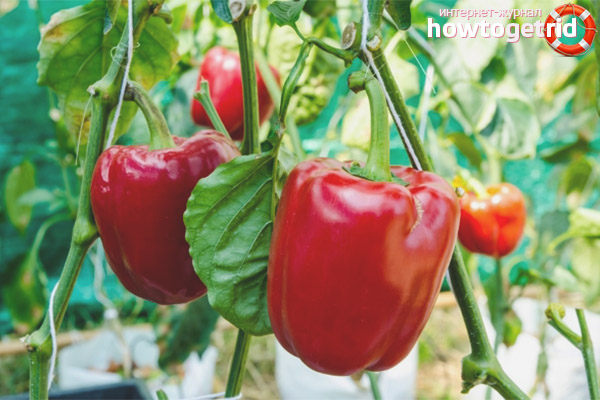The content of the article
Sweet pepper is a vegetable crop that is thermophilic and demanding in care. And if it is still possible to create optimal care for it, then it is almost impossible to influence the temperature when growing sweet pepper. For this reason, for Russian latitudes, it is preferable to use a domestic selection product. Such varieties are less whimsical to care for and are able to successfully produce a large amount of yield even under adverse weather conditions. Viking, a variety of early ripeness and high yield, is a similar type of pepper.
Grade characteristics
Every year, the Viking variety selects many vegetable growers for planting on their sites. He is appreciated for the large amount of harvest he gives, even if the summer was cool. And looking at the photos of ripe fruits, I want to know what these attractive bright red peppers taste like.
Among other types of sweet pepper - a thermophilic and whimsical plant care plant - the Viking variety is distinguished by the ability to bear fruit in a short time, even if there are no favorable conditions for this. It is successfully grown in all regions of Russia, with the exception of the regions of the Far North.
Despite the fact that the Viking sweet pepper variety is a relatively recent breeding development (it appeared in 1996), in a short time it has become quite popular. More and more growers when choosing vegetables for planting in their gardens stop at it. In the southern regions and the central zone of Russia, a large number of crops can be harvested from a plant planted on open beds. In regions with cooler climates, this variety is used for cultivation in greenhouse conditions.
Attention! Viking peppers have absolutely no bitterness, for this reason they can be consumed even during the period of technical ripeness, without waiting for the final ripening of the fruits.
Sweet pepper of this variety has many advantages over other types of this vegetable crop. These include the following:
- The variety is early ripe. The ripening period is 110 days. During this period, the fruits reach the stage of technical ripeness.
- The plant is low, so it is suitable for growing under film shelters and in low greenhouses.
- At the same time, from two to four fruits are formed on the bushes.
- The variety has good resistance to many diseases, especially to the harmful effects of tobacco mosaic.
- The plant is able to adapt to any weather.
- The variety is unpretentious and versatile.
- Ripening of fruits occurs in unison.
Ripe peppers have a large size and shape resembling a prism. The skin is smooth with a glossy sheen. The weight of one ripe fruit is on average about 200 grams, although you can also find fruits weighing 250-300 grams.
The wall thickness is 4-5 millimeters. Unripe fruits are colored green, finally ripening, acquire a bright red color.
Many growers note the excellent taste characteristics of peppers of this variety. The fruit pulp is juicy and dense, has a pleasant aroma. You can use the fruits in all areas of cooking - eat them fresh, as part of vegetable salads, preservation and pickling.
Growing recommendations

To plant this vegetable crop, it is recommended to choose a light and fertile soil. The best predecessors for growing sweet pepper are cucumbers, onions, cabbage, pumpkin.
Attention! It is not recommended to plant pepper of this variety in areas where potatoes, tomatoes or other types of pepper used to grow. If it is impossible to plant a plant in another place, you should fertilize the earth with a large amount of organic matter.
Seeds for seedlings are sown in late February or early March. To disinfect the seeds, they must first be treated with a manganese solution. After this, it is necessary to wrap the treated seeds in gauze moistened with water and place in a warm place so that they hatch faster.
Seedling tanks or peat pots should be prepared in advance by filling them with soil mixture. For these purposes, you can use ready-made purchased land, which is suitable for planting sweet pepper. Before planting the seeds, the soil is heated in the oven.
Attention! Seedlings of sweet pepper do not adapt well after a dive, so it is better to immediately plant the seeds in separate containers.
After this, you should water the soil well, cover the containers with glass or film material and put in a warm, well-lit place with a temperature of + 23- + 25 degrees. After the first sprouts appear, the shelter must be removed.
The plant is planted in pre-prepared wells according to a 60x40 pattern. Due to this, the necessary amount of nutrients will come to the bushes. Before planting, the holes must be filled with a mixture of soil and organic fertilizers. Then the plant is well watered and tied to a vertical support.
Since the variety is unpretentious in care, the only recommended agrotechnical measures are regular watering and fertilizing (once or twice during the growing season). It is also advisable to carry out loosening and weeding the soil.
The first crop can be harvested in July. And the plant will bear fruit until September.
Video: how often and how much to water pepper










Submit